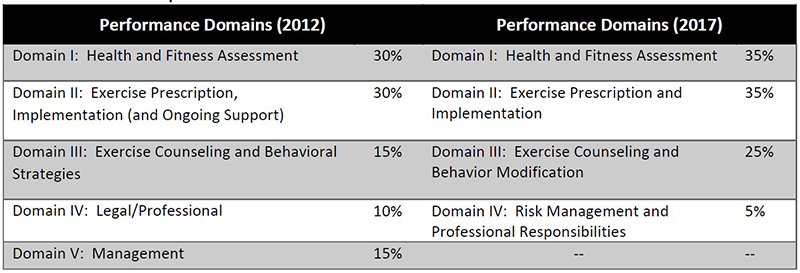2018 ACSM-CPT and ACSM-EP First-time Pass Rates Reach Historic Levels
In 2017, ACSM Certification completed its regularly scheduled job task analysis (JTA) study and update of the ACSM Certified Personal Trainer (ACSM-CPT) and ACSM Certified Exercise Physiologist (ACSM-EP) certification exams. The purpose of JTA updates, typically conducted every five to seven years, is to ensure that assessed knowledge, skill, and abilities of exercise professionals reflect current professional standards/practice and latest health/fitness research. Moreover, the JTA updates are required to maintain National Commission on Certifying Agencies (NCCA) accreditation.
The ACSM-CPT and ACSM-EP exams had substantive changes to the exam content outlines (see table 1 and 2) and include: (1) removal of business, marketing, and management topics; revised weighting of content domains (see tables 1 and 2); and, (3) inclusion of the new preparticipation screening algorithm.
Table 1. Crosswalk Comparison of 2012 and 2017 ACSM-CPT Performance Domains

Table 2. Crosswalk Comparison of 2012 and 2017 ACSM-EP Performance Domains

In an ongoing effort to provide greater transparency, ACSM included levels of cognitive complexity to its exam content outlines (Download ACSM-CPT outline or ACSM-EP outline). Cognitive complexity is a way of describing the extent to which a candidate should know or be able to perform a job task.
Jobs of exercise professionals can range between simple and complicated tasks. Much in the same way, the ACSM exams are written at different levels of cognitive complexity. A low level of cognitive processing requires simple recall of information, whereas a higher level of cognitive processing includes analysis, evaluations and judgments. ACSM uses three levels of cognitive challenge: recall, application and synthesis.
Finally, ACSM implemented the latest psychometric best practices to item development. This includes, but is not limited to, eliminating negatively worded items, complex multiple-choice items, and/or inclusion of multimedia assets. As a result, exam candidates have reported greater readability and higher fidelity items. “So, after taking the old exam twice and barely not passing, I took this new version and killed it,” said ACSM Certified Professional Liz White. “ACSM did a great job wording the questions on this updated exam compared to the last version. I can’t even express how much better the exam was overall!”
The net result of these efforts is that pass rates have jumped dramatically and are at historically high levels for the ACSM-CPT and ACSM-EP certification exams (See tables 3a and 3b).
Table 3a. First-time pass rates ACSM-CPT and ACSM-EP test takers (2014-2018)

Table 3b. 2018 first-time pass rates ACSM-CPT and ACSM-EP test takers (Q1-4)

Moving forward, ACSM will apply the same rigorous redevelopment standards to the ACSM Certified Group Exercise Instructor (ACSM-GEI) and ACSM Certified Clinical Exercise Physiologist (ACSM-CEP) certification exams.
For more information about how to get and stay certified with ACSM, visit our certification site or email ACSM Certification at certification@acsm.org.